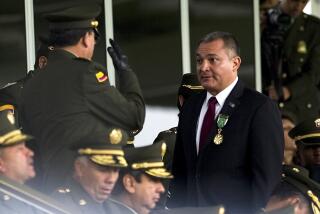Witness Tells of His Life in Prison Gang
The chief government witness in the federal trial of the Mexican Mafia prison gang took the stand Wednesday to begin testimony that promises to detail the organizationâs alleged violent activities and the roles prosecutors say the 13 defendants played in the gang.
Ernest âChucoâ Castro, over strenuous defense objections, testified about his own criminal career, how he joined the prison gang, how he killed and assaulted others on the organizationâs behalf and, ultimately, why he left La Eme, as the prison gang is called on the streets.
Speaking in a quiet but nervous voice, Castro, under questioning by Assistant U.S. Atty. Lisa Lench, said he decided to turn against the organization after he was arrested for possession of illegal weapons in November 1993. He left La Eme knowing that cooperating with authorities meant he was marked for death by the prison gang, he said.
âI was tired of criminal activities, the fear . . . [of getting killed],â he said. âItâs a pattern. Eventually everybody [involved in the organization] ends up getting stabbed.â
Until Castro showed up to testify, the trialâs first two months in the heavily guarded courtroom in the Edward R. Roybal Federal Building in downtown Los Angeles drew little notice, with few outsiders coming to witness the proceedings.
But the gallery was full Wednesday as courthouse employees and others came to watch the governmentâs star informant. Among the spectators was Lenchâs boss, U.S. Atty. Nora M. Manella. âIâm here to show support, although I donât think [Lench and fellow prosecutors Daniel Levin and Jack P. DiCanio] need it,â Manella said outside court.
Castro, 39, testified that he has been in trouble with the law since his early teens. A member of the Eastside street gang, Castro said he first heard of the Mexican Mafia when he was 15.
During stints at several California state prisons, including stays at the Chino State Prison, Castro assaulted several members believed to be on La Emeâs hit list, he testified. He said he never questioned such an order.
âAnyone who is on La Eme hit list has to be stabbed,â he said, adding that he agreed to commit the assaults âto get recognition from La Eme.â
While serving time at Chino, he met Benjamin âTopoâ Peters, a reputed leader of the Mexican Mafia and a defendant in the federal case. When Peters began telling him of the groupâs rules, Castro took Petersâ explanation to mean that he was âbeing prepped as a potential member of the Eme.â
In 1983, several years after his encounters with Peters at Chino, he said, he became a member of the Mexican Mafia while incarcerated at Folsom State Prison.
In court, Castro named each of the 13 defendants as members or associates of the Mexican Mafia--something each of them has denied. In the case of defendant Juan âChina Boyâ Arias, Castro said he knew Arias belonged to the Mexican Mafia because he had participated in the vote that made Arias a member.
Government lawyers were quite pleased about Castro finally appearing in court to provide crucial context and firsthand knowledge about the secretive prison gang. They smiled and gestured broadly to each other during the testimony.
Defense lawyers, however, were clearly unhappy. They have accused Castro of manipulating the secret audio and videotapes made of alleged Eme meetings, lying about his role with the organization and committing crimes while informing for the government.
At the end of Wednesdayâs proceedings, an agitated Manuel Araujo, attorney for defendant Joe âShaky Joeâ Hernandez, moved for a mistrial, arguing that Castroâs opening testimony lacked proper foundation and had lumped together the 13 defendants without any differentiation about who might have been present at crucial meetings secretly taped by government investigators.
But U.S. District Judge Ronald S.W. Lew overruled Araujo, saying that Lench had properly laid the foundation for Castroâs testimony.
Castro was scheduled to continue his testimony on direct examination Thursday, with government prosecutors intending to show the jury the March 27, 1994, videotaped meeting that Castro helped organize.
Castro, who was convicted and served time for voluntary manslaughter for one alleged Mexican Mafia-sanctioned hit, is in the federal witness protection program and is awaiting sentencing on state weapons charges.
More to Read
Sign up for Essential California
The most important California stories and recommendations in your inbox every morning.
You may occasionally receive promotional content from the Los Angeles Times.










